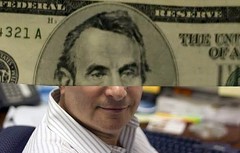
About UsThe Numismatic Bibliomania Society is a non-profit organization promoting numismatic literature. For more information please see our web site at coinbooks.org SubscriptionsThose wishing to become new E-Sylum subscribers (or wishing to Unsubscribe) can go to the following web page link MembershipThere is a membership application available on the web site Membership Application To join, print the application and return it with your check to the address printed on the application. Membership is only $15 to addresses in the U.S., $20 for First Class mail, and $25 elsewhere. For those without web access, write to: David M. Sundman, Secretary/TreasurerNumismatic Bibliomania Society AsylumFor Asylum mailing address changes and other membership questions, contact David at this email address: dsundman@LittletonCoin.com SubmissionsTo submit items for publication in The E-Sylum, just Reply to this message, or write to the Editor at this address: whomren@coinlibrary.com BUY THE BOOK BEFORE THE COINYou won't regret it! |
- WAYNE'S WORDS: THE E-SYLUM DECEMBER 13, 2009
- DEDICATED NUMISMATIC LITERATURE BUYER BRAVES ICY ROADS TO VIEW LOTS
- DAVID SKLOW SALE #9 CATALOGS ON THE WAY
- FANNING NUMISMATIC LITERATURE PUBLISHES THE BOOKSHELF, NOVEMBER 2009
- NEW BOOK: STANDARD CATALOG OF WORLD COINS 1801-1900 6TH EDITION
- NEW BOOK: U.S. POOL AND BILLIARD TOKENS
- BOOK REVIEW: CURRENCY AND BELIEF BY JOHN NEWLING
- ANS LIBRARY CATALOG NAMING CONTEST
- IS $2,500 FOR A HARDBOUND FORD SALE SET A BARGAIN?
- PRESENTATION: MEDALLIC HISTORY OF RELIGIOUS AND RACIAL INTOLERANCE
- MORE ON KOREIN'S COLLECTION GOBRECHT DOLLARS
- MORE ON COIN DEALER JAY PARRINO
- MORE ON WALTER BREEN'S EDUCATION
- QUERY: WHAT IS THIS MYSTERIOUS CHINA CREAM PITCHER CIPHER?
- QUERY: PITTSBURG AND MEXICAN TIN MINING COMPANY MEDAL
- DICK JOHNSON ON SAVING RARITIES FROM THE MELTING POT
- QUERY: THE MAINE PENNY
- WALL STREET JOURNAL REPORTS U.S. MINT CREDIT CARD REWARD SCAM
- COIN DROP STUNT BACKLASH
- ARTICLE EXAMINES MAN'S "IMPOSSIBLE" DISPLAY OF MEDALS
- ROBERT BURNS FEATURED ON NEW CLYDESDALE BANK £10 NOTE
- STOLEN ECSTACY PILL COLLECTION STORED IN COIN FOLDERS
- WAYNE'S NUMISMATIC DIARY: DECEMBER 13, 2009
- MONEYFACING - A NEW CRAZE SWEEPING THE WEB
- FEATURED WEB PAGE: THE NOBEL PRIZE MEDALS
WAYNE'S WORDS: THE E-SYLUM DECEMBER 13, 2009

Among our new subscribers this week are Macie Treash, Rob Vugteveen, Steve Costner, And Mike Gross. Welcome aboard! We now have 1,281 subscribers.
Thanks are due to John Salyer for helping with the images in this issue. This week we have updates from a number of numismatic literature dealers, and announcements of new books on diverse topics. To learn about the Bibliophile Who Braved the Storm , read on.
Wayne Homren
Numismatic Bibliomania Society
DEDICATED NUMISMATIC LITERATURE BUYER BRAVES ICY ROADS TO VIEW LOTS
George Kolbe writes:"Neither rain, nor sleet, nor gloom of night stays these couriers from the swift completion of their appointed rounds." Or dedicated lot viewers either, it appears.
Yesterday it snowed here in Crestline until late afternoon; then the snow turned to rain. Last night it was in the teens and the mountain roads are icy and treacherous today. Oregonian Nathan Markowitz, visiting for several days in San Diego, made the two hour drive here this Tuesday morning in a rental car, only to find the last stretch of road impassable.
Not to be denied, Nathan walked the last quarter mile or so on foot and is here viewing Stack Family auction lots as I write this. All while wearing tennis shoes, no less. Nathan will be receiving a complimentary hard-bound edition of the January 9, 2010 Ford Family Library auction sale catalogue in recognition of his determination.
DAVID SKLOW SALE #9 CATALOGS ON THE WAY
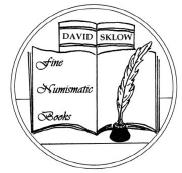 DAVID SKLOW - FINE NUMISMATIC BOOKS Sale #9 Closing Saturday
February 13, 2010: Catalogs will be mailed after Christmas and posted on my website by December 13th; Partial list of highlights are posted now; included are –
DAVID SKLOW - FINE NUMISMATIC BOOKS Sale #9 Closing Saturday
February 13, 2010: Catalogs will be mailed after Christmas and posted on my website by December 13th; Partial list of highlights are posted now; included are –
- 1942 studio photo of Abe Kosoff and B. Max Mehl at the ANA Convention Banquet;
- Editor's copies of several of Q. David Bower's works;
- QDB's First Fixed Price List;
- QDB's unpublished manuscript on Colonials;
- The Horace L.P. Brand original correspondence;
- The original correspondence of Walter P. Nichols;
- The papers of Robert Morris six volume set;
- J. H. Jongkee's The Kimonian Dekadrachms;
- Complete bound set [108 volumes] 1892-2000 of the Spink Numismatic Circular;
- Research files and typescript for the Dr. George Wilkins work;
- numerous works on treasure hunting, pirates and ship wrecks;
- Columbiana by Eglit;
- Deluxe bound Bluestone set of Grinnell catalogs;
- Kagin's 1977 ANA catalog deluxe leather edition;
- numerous deluxe bound editions of Bowers, Federal Brand, Ivy, Kagin, Katen, Kosoff, Kelly, Kreisberg, Lepczyk, Merkin, NASCA,
- A long run of deluxe and plated deluxe Superior catalogs;
- U.S. Cents 1798-99 by Clapp;
- Newcomb 1944 deluxe leather both thin & thick paper editions;
- over 300 individually listed auction catalogs of the 19th Century;
- Howard Newcomb's copy of Ed Lee's California Gold book;
- Breen & Gillio deluxe morocco leather #24 of 100 California Pioneer Gold book;
- Kagin's Pioneer Gold work in a deluxe full leather boxed edition;
- Part one of the Rev. Clunan British Works library, and much, much more.
www.finenumismaticbooks.com PH: (719) 302-5686, FAX: (719) 302-4933. EMAIL: numismaticbooks@aol.com. USPS: Box 6321, Colorado Springs, CO. 80934.!
FANNING NUMISMATIC LITERATURE PUBLISHES THE BOOKSHELF, NOVEMBER 2009
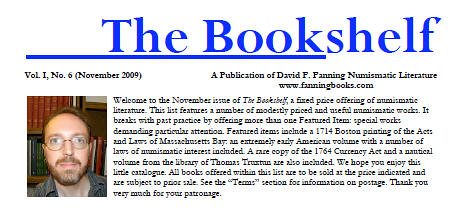
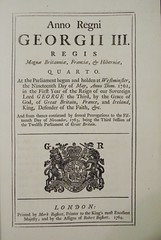 The November edition of The Bookshelf, David F. Fanning
Numismatic Literature's regular fixed-price list, has been posted on the firm's Web site at www.fanningbooks.com and is being sent to regular customers. A bit delayed by the company's
recent auction, the list includes a number of rare and important items, as well as useful, inexpensive works. David Fanning can be contacted at (614) 256-8915 or at dfanning@columbus.rr.com. A direct
link to the PDF version of the Bookshelf is: www.fanningbooks.com/Bookshelf6Web.pdf
The November edition of The Bookshelf, David F. Fanning
Numismatic Literature's regular fixed-price list, has been posted on the firm's Web site at www.fanningbooks.com and is being sent to regular customers. A bit delayed by the company's
recent auction, the list includes a number of rare and important items, as well as useful, inexpensive works. David Fanning can be contacted at (614) 256-8915 or at dfanning@columbus.rr.com. A direct
link to the PDF version of the Bookshelf is: www.fanningbooks.com/Bookshelf6Web.pdf
NEW BOOK: STANDARD CATALOG OF WORLD COINS 1801-1900 6TH EDITION
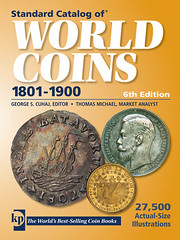 Krause Publications has
announced a new book, the 6th edition of the Standard Catalog of World Coins 1801-1900 by George S. Cuhaj and Thomas Michael. It's in the company's standard 8.25 x 10.25 softcover
format, with 1,248 pages and 27,500 black & white photos. Here's what the publisher's web site says:
Krause Publications has
announced a new book, the 6th edition of the Standard Catalog of World Coins 1801-1900 by George S. Cuhaj and Thomas Michael. It's in the company's standard 8.25 x 10.25 softcover
format, with 1,248 pages and 27,500 black & white photos. Here's what the publisher's web site says:
Much has changed since the last edition of the Standard Catalog of World Coins 1801-1900 came out. The metals market soared to record-breaking heights, and prices continue to stay strong. Meanwhile, the connection of collectors around the world and increased research efforts have lead to greater availability of coins that had been hard to come by in the past. With all these changes it helps to have the most comprehensive and current information about 19th century world coins, and now you can.
In this new edition of this Standard, you'll find:
- 27,500 actual-size coin illustrations
- Updated prices in five condition grades
- Details including diameter of the coin, metal, precious metal fineness and actual precious metal weight, and mintage when know
For more information, see: www.shopnumismaster.com/product/standard-catalog-world-coins
-1801-1900/world-coins/?r=NNWB449&p=NNWB449
NEW BOOK: U.S. POOL AND BILLIARD TOKENS
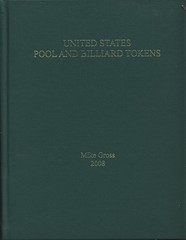

United States
Pool And Billiard
token book
Approximately 20,000 tokens listed by state.
includes a maverick section.
All tokens are valued.
A comprehensive owner – business index.
Hundreds of pictures. 1100 pages, 8½x11, hard bound.
6+ pounds of book, shipped insured, media mail.
$94.50 includes shipping & insurance.
Questions? Email me at:
mgross@onlinemac.com
MIKE GROSS
PO BOX 848
LAFAYETTE, OR.
97127
BOOK REVIEW: CURRENCY AND BELIEF BY JOHN NEWLING
 Philip Mernick of London recently sent me a nice
gift - a copy of Currency and Belief by John Newling. The conceptual artist recently spoke at the Royal Numismatic Society. His topic was "Between Sign and Symptom: the transformation of
Value, Coin and Material in the works of John Newling".
Philip Mernick of London recently sent me a nice
gift - a copy of Currency and Belief by John Newling. The conceptual artist recently spoke at the Royal Numismatic Society. His topic was "Between Sign and Symptom: the transformation of
Value, Coin and Material in the works of John Newling".
Any book picturing Communion Tokens on the cover is all right by me. I enjoyed reading it at lunchtime last week. Numismatists won't find anything much new about their hobby, but might still find Newling's work of interest. Somewhat like money artist J.S.G. Boggs, Newling prompts viewers of his work to think about what we value, and ties together values and belief in secular life and religion through imagery and viewer interaction.
The short 96-page hardcover book illustrates and describes several of Newling's installations. Philip informs me that a second edition is on the way. I remember fondly my visits with Philip and his brother Harry in London - they really made this visitor feel at home, and it's nice to stay in touch. Many thanks for thinking of me!
ANS LIBRARY CATALOG NAMING CONTEST
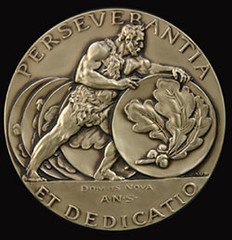 In 2010, the ANS Library will launch a new and improved
library catalog. This catalog needs a name. I would like to ask for the creative minds of the numismatic community to help with this, and so I am initiating a contest for the best name of our new
catalog. The person who submits the name that is chosen will win a $100 ANS gift certificate, which can be used for a wide variety of ANS purchases, including publications, library services,
membership, and more!
In 2010, the ANS Library will launch a new and improved
library catalog. This catalog needs a name. I would like to ask for the creative minds of the numismatic community to help with this, and so I am initiating a contest for the best name of our new
catalog. The person who submits the name that is chosen will win a $100 ANS gift certificate, which can be used for a wide variety of ANS purchases, including publications, library services,
membership, and more!
The contest deadline is February 15, 2010, so make sure to get your ideas in before then! To submit your entry, please email the contest address (contest at numismatics.org ) or mail your entry to "Attn: Library Contest" at the ANS headquarters in New York City. You can submit as many entries as you like. No phone calls please, as submissions must be made in writing.
For examples of other names and possible inspiration, you might look at what other libraries have done, such as BobCat (NYU library), Corsair (Morgan Library and Museum), Ambrosia (Blegen Library), etc. We are looking for something short and sweet but creative, with obvious relevance to the ANS collections.
THE BOOK BAZARRE
IS $2,500 FOR A HARDBOUND FORD SALE SET A BARGAIN?
I was reading the latest issue of Esylum, and saw the following tidbit:
"David F. Fanning Numismatic Literature held its third mail-bid auction on December 3. Featuring material from the libraries of John J. Ford, Jr. and Douglas Ball, the sale included many scarce works and specialized studies. A few highlights included: Lot 607: A complete, 21-volume set of hardcover Stack's Ford catalogues brought $2500."
Does anyone think that $2,500 for a complete 21 volume hard-bound set of the Ford sales is the greatest bargain in numismatics? That is just $119 per book for a wealth of knowledge. At the upcoming FUN sale, many people will drop six or seven figures on coins (most of it in the Syrup of Saints™ sale), but will scoff at spending $2,500 for a set of books. For shame.
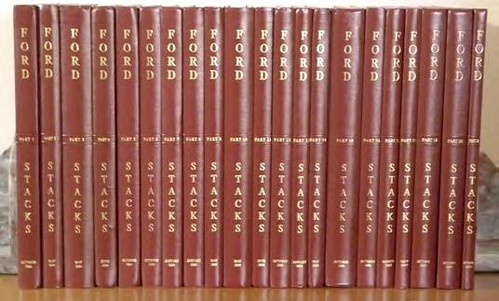
Sounds cheap to me.....
Considering that a single HB Ford I sale brought over $400 in a Kolbe sale last year, to pick the entire set up at issue price is a good deal for someone.
No, it can't possibly be "the greatest bargain" considering that many of us received a complete set of paperback Ford catalogs *free of charge* one by one as the auctions took place. I would say that *free* is a much greater bargain than $2500 cost !!
I agree - I received all of the soft-bound copies for free also. Hey, if you're a book-lover who wants to just admire the hard-bound copies sitting on your shelf, then go for it. I'll admit I do have a few special hard-bound catalogs in my library but they are only in my specific area of collecting. The Ford catalogs don't do anything for me.
I think it's a deal, but not the "greatest" deal. I'd take the card cover set for $500 (I already have one) and spend the other $2,000 on cooler things. On the other hand, $2,000 isn't going to go very far in the Kolbe Stack's family sale. Pre-sale estimate on the 1st six years of Numismatist is $25k...it'll likely hammer at $35k+.
It may be a bargain, but not for the information. The information is only worth (roughly) $500, because that's what you can get it for in another format. The extra $2000 for the bindings has nothing to do with "information".
Naturally, Your Editor is in the "it's a bargain" camp. I have a hardbound set that I purchased individually by subscription. I actually had a subscription for TWO sets initially,
and when I was moving a few years ago I sold my duplicate copies at double and triple the issue price to raise cash and clear off some shelf space.
I consider the set a cornerstone of my numismatic library, or of any library of American numismatic literature. I fully expect the price to only go up from here, and wouldn't be surprised to see
sets selling in the $5,000+ range someday. But only time will tell.
To read the complete thread, see: Is $2,500 for a complete, 21 volume hard-bound set of Stack's Ford catalogs the greatest bargain in numismatics? (forums.collectors.com/messageview.cfm?catid=26&threadid=752303)
PRESENTATION: MEDALLIC HISTORY OF RELIGIOUS AND RACIAL INTOLERANCE
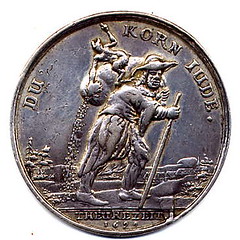

DU KORN JUDE (THE CORN JEW)
by Christian Wermuth, Germany, 1694, Silver, 36 mm
The main type of German anti-Semitic medal, called the "Korn Jude" (the Corn or Grain Jew) medal, appeared at the end of the seventeenth century. The prototype first emerged in 1694 (shown here). In that year heavy rains and a grasshopper plague swept through Germany. Food prices increased, speculation rose and the starving people blamed the Jews, shown on the medal as the Corn or Grain Jew dealer. Similar medals were issued over a period of some eighty years, from 1694 to 1773. They were issued during hard times, when prices went up and the popular scapegoat was the Jew, depicted as a diabolic speculator.
MORE ON KOREIN'S COLLECTION GOBRECHT DOLLARS
Saul Teichman writes: With regard to Dr. Korein's collection, it
contained the following Gobrecht dollars and the one half dollar splasher the last time I visited him. I do not know if the collection grew beyond what is listed below but the new book is missing 30
pieces he purchased since then.
With regard to Dr. Korein's collection, it
contained the following Gobrecht dollars and the one half dollar splasher the last time I visited him. I do not know if the collection grew beyond what is listed below but the new book is missing 30
pieces he purchased since then.
Splashers - 4
- Half Dollar J-A1837-2
- Dollar J-A1836-4, J-A1836-5, J-A1836-8
Gobrecht Dollars - 96
- J58 2 in alignment IV, 4 in alignment III
- J59 alignment III
- J60 60 examples, 26 in alignment I, 12 in alignment II, 5 in alignment III, 17 in alignment IV
- J61 alignment IV
- J62 alignment III
- J63 alignment III
- J64 alignment III
- J65 alignment III
- J84 1 in alignment IV, 6 in alignment III
- J85 2 in alignment III
- J87 1 in alignment III
- J88 1 in alignment III
- J89 1 in alignment III
- J104 3 in alignment III, 7 in alignment IV
- J105 1 in alignment III
- J108 1 in alignment III
From a completion standpoint, it is missing only the 2 1839 copper dollars J107 and J109 and a latest state restrike J60 in alignment III with die rust in front of Liberty's face from being complete.
To read the earlier E-Sylum article, see: ON KOREIN'S COLLECTION GOBRECHT DOLLARS AT THE ANS (www.coinbooks.org/esylum_v12n49a09.html)
MORE ON COIN DEALER JAY PARRINO
Regarding dealer Jay Parrino, an E-Sylum reader writes:
Here are a few things I observed and heard years ago.
Parrino was said to have worked at a casino in Las Vegas known as 'The Mint'. Parrino's coin business was also known as 'The Mint'.
At the height of his coin career in the mid-90's, Parrino had a booklet prepared that was inserted in the middle of a Coin World issue just before a major show. Unless I'm mistaken, it was distributed just before the FUN show. The booklet contained most or all of the expensive coins in his inventory at the time, including much of the fabulous large cent collection he bought from Eric Streiner (with Stack's help).
Having never seen anything like this booklet, before or since, I was very intrigued. I decided to add up the prices in the booklet. As I recall, the total came to about $32,000,000.00. But there was one item in the booklet that was 'P.O.R.'. That was a 1913 liberty nickel. I took the liberty of adding $3,000,000.00 for the nickel, which made the total $35,000,000.00.
Regarding the $1,000,000.00 display, I'm virtually certain there were never any $10,000,00 gold notes used in the display. I believe these are unknown in private hands. Although there may have been two separate displays, both would have contained only $10,000.00 Federal Reserve Notes. The display that Parrino bought had $10,000.00 notes from the New York district only.
Regarding the million-dollar display of banknotes Parrino purchased, Davd Lange writes:
I believe you misinterpreted my comments published in this week's issue when you observed that "The recreated version, later sold to Parrino, was made up of Federal Reserve Notes. -Editor"
My point was that neither the original nor recreated displays could have included gold certificates, as claimed in the newspaper article. FRNs must have been used for both editions, but that just doesn't sound as glamorous to the media.
I also wanted to expand on what Tom DeLorey said: The 1969 cut-off date applied only to the distribution of $500 and $1000 FRNs, which ceased to be issued on July 14. The 1949 date applied to $5000 and $10,000 notes.
To read the earlier E-Sylum article, see: QUERY: COIN DEALER JAY PARRINO (www.coinbooks.org/esylum_v12n49a11.html)
MORE ON WALTER BREEN'S EDUCATION
In The E-Sylum v12 n49 Leon Saryan suggested: "It should be possible to contact the registrar and make an inquiry about Breen's record." I do not know that that is true. My understanding of FERPA (Family Educational Reporting Privacy Act) plus attempts of my own, all point in the opposite direction.
Working on a master's myself in social science, I had a professor who was so inept that several of us attempted to validate that person's credentials. We failed. Though we had the dates of attendances and degrees from a curriculum vitae, the institutions refused to answer even that a degree was ever granted. You must have written permission from the subject to view the records ... and with dead people, that can be difficult.
Also, I noticed that nearly every citation about Breen repeats the same phrase, "... earning his Master's degree from University of California, Berkeley in 1966. ..."
However, I did find this: Before Stonewall: Activists for Gay and Lesbian Rights in Historical Context by Vern L. Bullough, RN, PhD. Binghamton, New York: Hayworth Press, 2002. Page 313-314:
"He later completed the premedical course at Columbia and went on to complete a master's degree at University of California, Berkeley, in 1966, producing a thesis on "The Changing Social Status of the Musician." He was an accomplished pianist and an acknowledged expert on medieval and baroque music.
"It is one of his specialized books, Dies and Coinage, published in 1962 by Robert Bashlow, which provides a link to our topic here. Breen and Bashlow shared more interests than numismatics; both had an interest in younger males." (The rest of the paragraph deviates from numismatics entirely.)
Was Breen's master's degree in music or in sociology or something else?
To read the earlier E-Sylum article, see: MORE ON WALTER BREEN AT JOHNS HOPKINS (www.coinbooks.org/esylum_v12n49a12.html)
QUERY: WHAT IS THIS MYSTERIOUS CHINA CREAM PITCHER CIPHER?
Anne E. Bentley of the Massachusetts Historical Society writes:
I'm wondering if any of your readers have come across this cipher in their collecting. Although this example is a china cream pitcher, the logo seems to resemble something one would find on a token or medal. Obviously a New England group, but I can't make the initials fit anything sensible… Season's greetings to all.
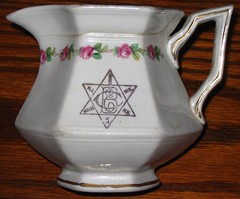
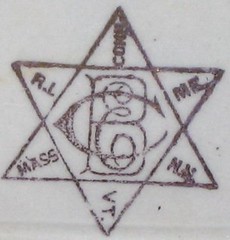
QUERY: PITTSBURG AND MEXICAN TIN MINING COMPANY MEDAL
Ed Krivoniak writes:
I am finishing up an article on the Pittsburg and Mexican Tin Mining Company and medal. I just have to footnote it before I send it off. The speech was delivered at the September meeting of the Sphinx Society and was very well received. I have located six specimens of the medal in Pittsburgh and have been wondering if there is any way to find out about others around the world. Do you think The E-Sylum readership can help?


So - have any of our readers seen examples of this medal? Has an example appeared in an auction or fixed price listing? Thanks. -Editor
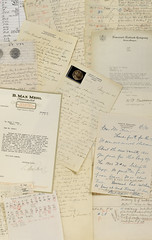

DICK JOHNSON ON SAVING RARITIES FROM THE MELTING POT
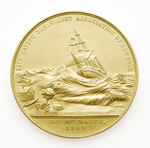 The final chapter has been written for the gold Tiffany
Life Saving Medal tuned in for scrap at the Liverpool England jewelry firm W.J. Edwards but was saved from the melting pot. It was mentioned two weeks back in The E-Sylum (vol 12, no 47, art
17).
The final chapter has been written for the gold Tiffany
Life Saving Medal tuned in for scrap at the Liverpool England jewelry firm W.J. Edwards but was saved from the melting pot. It was mentioned two weeks back in The E-Sylum (vol 12, no 47, art
17).
The medal sold November 30 for £2,400 ($3,902) at the Fellows & Son London auction firm. It received a hammer price of £2,883 plus a buyer's fee of 20.13%.
 How it got from the Newark, New Jersey, factory of
Tiffany & Co where it was struck in 1911 to Liverpool 98 years later is an itinerary we may never learn. But it does recall other instances of rare items saved from the melting pot once turned in for
scrap.
How it got from the Newark, New Jersey, factory of
Tiffany & Co where it was struck in 1911 to Liverpool 98 years later is an itinerary we may never learn. But it does recall other instances of rare items saved from the melting pot once turned in for
scrap.
In the early eighties during great silver melt, initiated by the Hunt Brothers attempt to corner the world's silver supply, a lot of the metal was sold to metal dealers in and around the Diamond District in Midtown Manhattan. The story has been told that the owners of these firms were kept busy examining what was redeemed each day. They would sort through the precious metal flotsam and retrieve any item with a potential value greater than the inflated metal content.
There is a concept here of human nature to strive for the greatest profit. But that situation has a term, firm hand. The seller did not have a firm hand, he preferred the immediate cash to holding it for any greater profit later on. The owner of precious metal firm had a firm hand in that he could retain the item for perhaps an undetermined time. The owner had to make quick decisions, "Would this ever be worth more than the inflated price he paid for the item today?" Too bad tons of precious metal items were destroyed forever.
While this Tiffany gold medal was saved, many gold medals have been melted over the years, those that were not in firm hands. The most sorrowful story is that of Phoebe Ann Mosey, "Annie Oakley," who as a sharpshooter received dozens of gold medals in shooting competitions. Instead of selling her medals outright -- wouldn't gun collectors covet owing just one of those! -- she had all her gold medals melted. She gave the money to the poor, but destroyed a heritage of her achievements.
To read the earlier E-Sylum article, see: 1911 GOLD TIFFANY LIFE SAVING MEDAL OFFERED (www.coinbooks.org/esylum_v12n47a17.html)
QUERY: THE MAINE PENNY
 The Maine penny, also referred to as the Goddard coin, is a Norwegian
silver penny dating to the reign of Olaf Kyrre (1067â€"1093 AD). The Maine State Museum describes it as "the only pre-Columbian Norse artifact generally regarded as genuine found
within the United States." The American Numismatic Society has stated that "There is no reliable confirmation on the documentation of the Goddard coin, and much circumstantial evidence
suggests that someone was deliberately trying to manipulate or obfuscate the situation. The Norse coin from Maine should probably be considered a hoax." However an extensive analysis by Edmund
Carpenter published by the Rock Foundation concluded "Not proven."
The Maine penny, also referred to as the Goddard coin, is a Norwegian
silver penny dating to the reign of Olaf Kyrre (1067â€"1093 AD). The Maine State Museum describes it as "the only pre-Columbian Norse artifact generally regarded as genuine found
within the United States." The American Numismatic Society has stated that "There is no reliable confirmation on the documentation of the Goddard coin, and much circumstantial evidence
suggests that someone was deliberately trying to manipulate or obfuscate the situation. The Norse coin from Maine should probably be considered a hoax." However an extensive analysis by Edmund
Carpenter published by the Rock Foundation concluded "Not proven."
A local resident, Guy Mellgren, said that he found this coin on August 18, 1957, at the Goddard site, the extensive archeological remains of an old Native American settlement at Naskeag Point, Brooklin, Maine on Penobscot Bay. . . Over a lengthy period, a collection of 30,000 items from the site were donated to the Maine State Museum. The coin was at first identified as a British penny from the 12th century and much of the circumstances of its finding were not preserved in the record (as was the case with the majority of the 30,000 finds). . . .
In 1978, experts from London considered that it might be Norse. Kolbjorn Skaare of the University of Oslo determined the coin had been minted between 1065 and 1080 AD and widely circulated in the twelfth and thirteenth centuries. The Goddard site has been dated to 1180-1235 (ie well within the circulation period of pennies of this type) and the people living there at the time are generally considered to be ancestors of the Penobscot. While the date is around two hundred years after the last of the Vinland voyages described by Norse sagas it is well within the period during which Vikings are believed to have visited North America.
By some accounts the penny was found with a perforation, hinting it was used as a pendant. This area of the coin is said to have since crumbled to dust from corrosion.
The penny's coastal origin has been offered as evidence either that the Vikings traveled further south than Newfoundland or that the coin might have been traded locally. However, the penny was the only Norse artifact found at the site, which according to substantial evidence was a hub in a large native trade network. For example, a single artifact generally identified as a Dorset Eskimo burin was also recovered there, and may support the idea that both the burrin and the penny could plausibly have come to Maine through native trade channels from Viking sources in Labrador or Newfoundland.
The identity of the Maine Penny as an Olaf Kyrre silver penny is not in doubt. While the Maine Museum and the Smithsonian website favor the view that it was found at the site and is therefore evidence of Viking presence on the North American continent the possibility that it may be a hoax has been raised. . . There is no solid evidence of a hoax, yet there are questionable aspects regarding the archaeologist that produced the coin to leave its provenance in doubt.
To read the complete article, see: RECOVERED HISTORY: THE MAINE PENNY (prorev.com/2009/12/recovered-history-maine-penny.html)
THE BOOK BAZARRE
WALL STREET JOURNAL REPORTS U.S. MINT CREDIT CARD REWARD SCAM
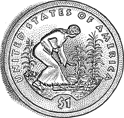 Enthusiasts of frequent-flier mileage have all
kinds of crazy strategies for racking up credits, but few have been as quick and easy as turning coins into miles.
Enthusiasts of frequent-flier mileage have all
kinds of crazy strategies for racking up credits, but few have been as quick and easy as turning coins into miles.
At least several hundred mile-junkies discovered that a free shipping offer on presidential and Native American $1 coins, sold at face value by the U.S. Mint, amounted to printing free frequent-flier miles. Mileage lovers ordered more than $1 million in coins until the Mint started identifying them and cutting them off.
Coin buyers charged the purchases, sold in boxes of 250 coins, to a credit card that offers frequent-flier mile awards, then took the shipments straight to the bank. They then used the coins they deposited to pay their credit-card bills. Their only cost: the car trip to make the deposit.
Richard Baum, a software-company consultant who lives in New Jersey, ordered 15,000 coins. "I never unrolled them," he says. "The UPS guy put them directly in my trunk."
Patricia Hansen, a San Diego retiree who loves to travel, ordered $10,000 in coins from the Mint. "My husband took them to the bank," Ms. Hansen says, and she earned 10,000 miles toward free or upgraded travel.
Even with all the offers that are available, the deal the Mint offers -- free miles without spending any dollars -- is unique. The Mint says the dollar-coin free-shipping offer began in June 2008. About $130 million in coins have been issued to 40,000 buyers, mostly coin collectors, community banks and small businesses such as vending-machine companies and car washes.
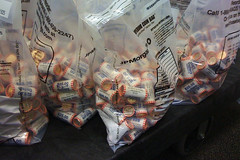 The Mint says it costs, on average, about $3 to ship each 250-coin box.
So $10,000 in coins would be 40 boxes, or $120 in shipping. As for credit-card costs to the government, a Treasury Department agency handles all government credit-card transactions and negotiates
costs. No particular credit-card expense is charged to the Mint, a spokesman says.
The Mint says it costs, on average, about $3 to ship each 250-coin box.
So $10,000 in coins would be 40 boxes, or $120 in shipping. As for credit-card costs to the government, a Treasury Department agency handles all government credit-card transactions and negotiates
costs. No particular credit-card expense is charged to the Mint, a spokesman says.
In late August and September, officials noticed a sharp uptick in "large repetitive orders" from a group of individuals, Mint spokesman Tom Jurkowsky says. At about the same time, the Mint received reports from banks around the country that coins were being deposited that were still in their U.S. Mint boxes, he says.
Officials found Internet chat rooms where the coins-for-miles scheme was detailed. Letters were sent to customers asking whether their intended use complied with the program's purpose. Customers who didn't respond were blocked from the program, Mr. Jurkowsky says. Fewer than 400 buyers were blocked, he says.
"Is this illegal? No. Is it the right thing to do? No, it's not what the program is intended to do," Mr. Jurkowsky says.
To read the complete article, see: Miles for Nothing: How the Government Helped Frequent Fliers Make a Mint (online.wsj.com/article/SB126014168569179245.html)
COIN DROP STUNT BACKLASH
I enjoyed reading the article in the December 6, 2009 edition (v12#49), "Ideal Coin Show Publicity: Houston Coin Club," about promoting the show with the exhibit of a 1943 bronze cent. After 30 years of helping to promote various coin shows (and 30 years of working in the print and broadcast news media prior to turning to The Dark Side of the Force -- PR), I've learned this: You have to give the non-collecting public a solid reason to get off the couch and come to the show.
I used to believe that a "coin drop" stunt -- deliberately placing a rare coin into circulation -- was a way to do that. But now I discourage that kind of promotion. At the 1992 ANA convention in Orlando, Florida, someone from (what was then) Krause Publications was handling the coin drop and arranged for a TV news crew to follow him as he made a purchase using a rare coin as part of the pocket change. However, the TV crew was never taken into the coin show! The coin dropper met them outside a nearby hotel. So, the TV coverage that night was only about a rare coin in change in the Orlando area with no video of the coin show!
It was then I realized that you need a compelling reason for the general public to come to the show. A rare coin in circulation may prompt them to closely look at their pocket change, but probably won't get them in the door unless they find it or are spurred to bring in Grandpa's old coins stored in a tin can. You need something that will attract larger numbers of people, and that's usually A) an eye-opening exhibit such as a six-figure 1943 bronze cent or the BEP's $100,000 bills or the SS Central America Ship of Gold display (which, by the way, is coming out of dry dock and will be at the February Long Beach Expo) and/or B) free appraisals of old coins and bank notes.
Even the best, widely-promoted come-and-see-it exhibit, though, can be thwarted by bad weather on the show days or an inconvenient location for the public to visit. And, despite my don't-do-a-coin-drop mantra for promoting shows, I happily used coin drops in April 2006 to simultaneously promote National Coin Week and a new edition of Scott Travers' book, "The Coin Collector's Survival Manual."
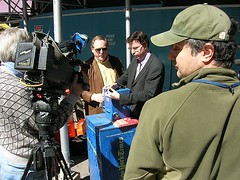
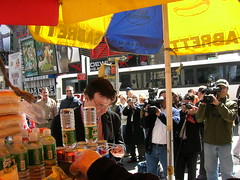
Photos used with permission of Donn Pearlman. All rights reserved.
Scott used rare coins to purchase some items from push cart vendors in midtown Manhattan. The New York Times ran a story that promoted National Coin Week and the book, and we had representatives of virtually every local TV station and news network cover one of the coin drops. Most of them, too, mentioned both National Coin Week and Scott's book in their subsequent coverage. Here's a photo of Scott showing the news media the 1909-S V.D.B. Lincoln cent he was about to use with other loose change to buy a bottle of water from an unsuspecting vendor a block away.
Now you ask, "How could he be an unsuspecting vendor with all the TV cameras following him?" Remember, this was in Times Square. People who live and work there are used to seeing camera crews for television and movies. And when this particular vendor noticed the cameras as Scott was making his purchase, I simply told him, "I think he's some personality from Canada....."
Regarding the 1943 copper cent, Don Cleveland adds:
Your recent article in E-Sylum about 1943 copper one cent coins reminds me of my high-school chemistry class. My friends and I, who were enrolled in the Lebanon, Oregon, high-school's chemistry class back in the late 1950s, found we could use electrolysis to copper coat the "white" 1943 "pennies" which still circulated in those days.
Utilizing a solution made from copper sulfate, we plated a couple of rolls of these coins. We eventually passed the coins into circulation in the local area. I believe students in nearby Sweet Home and Albany, Oregon, schools (and probably all across the U.S.) also produced a few. They are easily identified: their steel cores still react to a magnet.
To read the earlier E-Sylum article, see: IDEAL COIN SHOW PUBLICITY: HOUSTON COIN CLUB (www.coinbooks.org/esylum_v12n49a20.html)
THE BOOK BAZARRE
ARTICLE EXAMINES MAN'S "IMPOSSIBLE" DISPLAY OF MEDALS
A man who marched at a Remembrance Day parade with an impossible array of medals was named last night as carpenter Roger Day, 61. Neighbours said the keen amateur actor was once thrown out of his local pub in a row over an SAS badge he was wearing. Mr Day denied he was a conman and said the 17 medals - including top bravery awards - were 'pukka'.
But medals expert Martin Harrison said: 'He would be world-famous - and some sort of Rambo character - if he had been awarded them all.' A drive to identify the mystery medal man was launched after he was pictured marching alongside brave servicemen at the November 11 parade in Bedworth, Warwickshire.
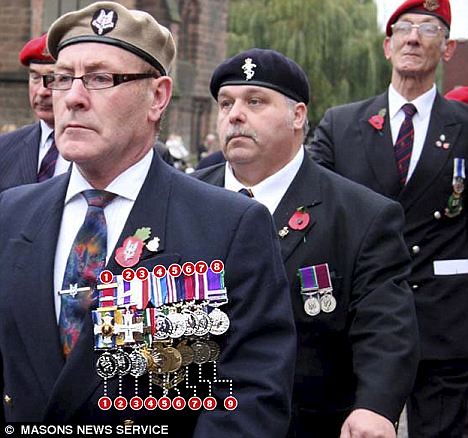
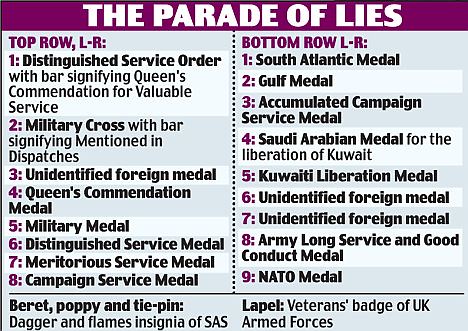
Mr Day was tracked down to his home in Earl Shilton, near Hinckley, Leicestershire, where it emerged that he is a regular churchgoer who sings in the choir.
Mr Day, who wore a beige SAS beret at the parade, insisted his medals were genuine, but said the Official Secrets Act stopped him giving details. He said: 'They're all proper, pukka campaign medals. Medals I won in conflicts while I was serving with the British forces. All I can say is South Atlantic the Gulf, Kuwait and one or two other stations.'
The medals included the Distinguished Service Order and Military Cross - the highest bravery awards after the Victoria Cross - campaign awards from Korea and the Falklands, medals for both officers and other ranks and foreign decorations.
Mr Harrison, a squadron leader with the RAF Volunteer Reserve and liaison officer at the Bedworth Armistice Day Parade committee, said: 'It is a ridiculous, ludicrous combination of medals which is unheard of.'
Hinckley Ex-Servicemen's Club has launched an investigation. Secretary Paul Savage said: 'If he has been wearing medals he is not entitled to he will be facing a £1,000 fine and he will be thrown out of the club. 'Most members consider it disgusting for someone to wear medals that do not belong to them. It makes a mockery of everything.'
A carpenter who marched in a Remembrance Day parade wearing an 'impossible collection' of military medals has been arrested on suspicion of deception.
military experts said no single serviceman could have been awarded all the medals - some of which were from the Korean War, which ended when Mr Day was still in primary school.
Yesterday it emerged Mr Day had been arrested on suspicion of 'wearing military medals without authority as to be calculated to deceive'. A Warwickshire Police spokesman said Mr Day was arrested under section 197 of the Army Act 1955, which makes wearing decorations without authority a criminal offence, after attending a police station for a pre-arranged appointment.
From http://www.urbandictionary.com/:
A slang-term used in British English to describe something as "first class" or "absolutely genuine". That DVD is no "bootleg". It's pukka.
The derivation of the term appears in www.merriam-webster.com:
"Pukka" tends to evoke the height of 18th- and 19th-century British imperialism in India, and, indeed, it was first used in English at the 1775 trial of Maha Rajah Nundocomar, who was accused of forgery and tried by a British court in Bengal. The word is borrowed from Hindi and Urdu "pakkā," which means "solid." The English speakers who borrowed it applied the "sound and reliable" sense of "solid" and thus the word came to mean "genuine." As the British Raj waned, "pukka" was occasionally appended to "sahib" (an Anglo-Indian word for a European of some social or official status). That expression is sometimes used as a compliment for an elegant and refined gentleman, but it can also imply that someone is overbearing and pretentious.
Hmmm - "overbearing and pretentious"? Sounds like a good description of someone wearing an impossible array of medals on their chest. As for "pukka", one never knows when a vocabulary word will come in handy. Years ago in my single days, I went to a movie with John Burns, now a numismatic literature dealer. We saw "Educating Rita" and at one point in the film, John and I were the only people in the audience laughing at one of Michael Caine's lines. Apparently we were the only people present who knew what a "wanker" was. -Editor
To read the complete article, see: Medals are pukka...but
I'm sworn to silence on how I won them, says the parade 'fraud' (http://www.dailymail.co.uk/news/article-1233634/
Fake-war-veteran-Roger-Day-Medals-pukka--Im-sworn-silence-I-won-them.html)
ROBERT BURNS FEATURED ON NEW CLYDESDALE BANK £10 NOTE
Robert Burns, one of Scotland's most famous sons, is featured on Clydesdale Bank's new £10 note, which is now in circulation. This note is the fourth of Clydesdale Bank's new world heritage banknotes.
As well as featuring ‘The Bard' on the front, the £10 note will also depict an iconic image of Edinburgh's Old and New Towns on the reverse.
Clydesdale Bank's new note collection showcases the best of Scotland's heritage, people and culture and is the first time in more than 20 years the Bank has launched a completely new set of notes.
The front of each new note will honour a prominent and innovative Scot while the reverse will feature one of Scotland's five World Heritage Sites.
Clydesdale Bank is the largest issuer of banknotes in Scotland, with more than £1.1billion in circulation in any given week.
To read the complete article, see: Clydesdale Bank features Robert Burns on its new £10 note (www.pr-inside.com/clydesdale-bank-features-robert-burns-r1621190.htm)
STOLEN ECSTACY PILL COLLECTION STORED IN COIN FOLDERS
Don't keep a collection of anything but coins in coin albums. That advice was neglected by a 46-year old Dutchman who recently had a collection stolen from his home that was stored in "coin collecting folders."
First of all thieves are savvy. Anything kept in coin containers has got to be valuable, coins or not. But what kind of collection was stolen from this Dutchman recently? Ecstasy pills, 2,400 hundred of them!
It was his collection that took twenty years to acquire. "My passion," he said, "for collecting comes from the varied [selection] of colors, shapes and logos that are printed on the pills."
Despite the fact about 40 of the pills are poisonous and it is illegal to possess these pills, even in Holland, the police said they tended to believe the unnamed man. A police spokeswoman said "Why would you make something like this up?"
Likewise we don't make up these stories either. See: Dutch man reports theft of Ecstasy pill collection (www.google.com/hostednews/ap/article/ALeqM5jg2yveyEEREp-NR6MP3x8LcssyvQD9CGLPU00)
WAYNE'S NUMISMATIC DIARY: DECEMBER 13, 2009
This week was a fun one. On Tuesday night I attended the December holiday dinner of Nummis Nova, my Northern Virginia numismatic social group. A number of spouses were in attendance, although mine was at home minding our kids - two of them were sick with pinkeye.The dinner was held at an upscale Italian Restaurant. We had a private room, and the dinner and drinks were superb. I enjoyed speaking with everyone. Attendees included Roger Burdette, Tom Kays, Chris Neuzil, Joe Levine, Bill Eckberg, Mike Packard, Wayne Herndon, Jon Radel, and Julian Leidman. Regular Dave Schenkman was out due to a bad cold.
Conversation topics were all over the map and largely non-numismatic, but we did touch on the 1933 Double Eagle situation and the recent theft of Julian's numismatic stock. He and his wife were truly touched by the outpouring of support from the numismatic fraternity, and naturally quite relieved to have had most of the stolen items returned.
Before leaving I spoke with Jon Radel and Wayne and Karin Herndon to plan Saturday's event for kids at the Annandale Coin Show. I still had to complete the slides for my presentation, which I didn't complete until Friday night.
Saturday morning I arrived at the show around 10am. I walked to the back row to speak to numismatic literature dealer John Burns, who I hadn't seen in some time. He kindly pointed out the grey appearing on my temples. But I had no time for small talk or perusing inventory - I rushed to get our room set up.
E-Sylum subscriber Mike Hudson was there with his whole family, as was Jon and his son Joe. We got the room set up and I gave a presentation to 16 kids and their parents - we had about 30 people in the room. Mike took some pictures. I quizzed the kids on the Lincoln Cent and Jefferson Nickel. The kids were great, and when we digressed into a discussion of mint marks, one of them not only knew Dahlonega, he could pronounce it as well!


At the end I called an auction of 25 lots of donated material. The kids seemed to have a blast, and I enjoyed doing it. All in all, it was a great morning. While Jon and Mike helped, I packed up so I could leave at 12:30 to get to my 9-year-old son Tyler's basketball game. I'm glad I did. With his team down 4-6 as the end of the first half approached, "Cool Hand Tyler" got the ball and winged it toward the basket. Buzzer sounds. Ball slams backboard and swishes in for three points, putting his team ahead 7-6. The crowd roared and no one was more surprised than Tyler. But all his practice in our cul-de-sac paid off.
The other team must have been stunned into submission - they never scored another point. Final score, 27-6. His team won another game at 4pm 24-12 and a third on Sunday 41-8. His brother Christopher's team won as well Saturday night. All this left little time for The E-Sylum, so I was up past 12:30am finishing this issue. But it's all fun.
MONEYFACING - A NEW CRAZE SWEEPING THE WEB
Photographs of folded-over banknotes placed in front of a person's half-visible face are littering the web. A truly international pastime, the notes being used come from as far afield as Singapore and the US. Closer to home, many Britons are having fun with our own banknotes. The Queen is proving to be the most popular, followed by Sir Edward Elgar and Sir John Houblon.

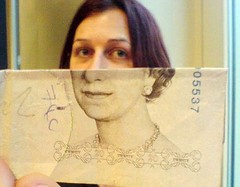
Click here to view a slideshow of images: www.flickr.com/photos/coinbooks/sets/72157622989797646/show/ .
To read the complete article, see: Creasing up: Banking on a funny photo with the 'moneyfacing' craze sweeping the web (www.dailymail.co.uk/news/article-1234050/Creasing-Banking-funny-photo-moneyfacing-craze-sweeping-web.html)
FEATURED WEB PAGE: THE NOBEL PRIZE MEDALS
This week's Featured Web page is suggested by Alan Luedeking, who writes:
Here's an interesting article on the Nobel organization's official website. This may add fuel to the cast versus struck question. I do not believe it is written by a numismatist. No doubt the three "temporary" base metal medals of 1901 would fetch as much or more as the gold ones at auction today, don't you think?

Nobel Peace Medal
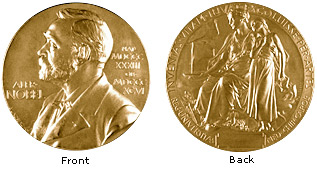
Nobel Medal in Medicine
According to the Statutes of the Nobel Foundation, given by the King in Council on June 29, 1900, "the prize-awarding bodies shall present to each prize-winner an assignment for the amount of the prize, a diploma, and a gold medal bearing the image of the testator and an appropriate inscription." The medals for Physics, Chemistry, Physiology or Medicine and Literature were modeled by the Swedish sculptor and engraver Erik Lindberg and the Peace medal by the Norwegian sculptor Gustav Vigeland. The medal for The Sveriges Riksbank Prize in Economic Sciences in Memory of Alfred Nobel (established in 1968 in connection with the 300th anniversary of the Sveriges Riksbank), was designed by Gunvor Svensson-Lundqvist.
nobelprize.org/nobel_prizes/medals/

